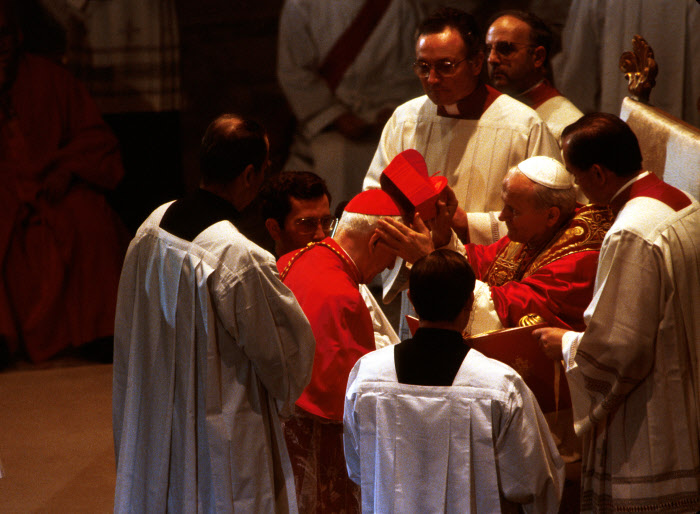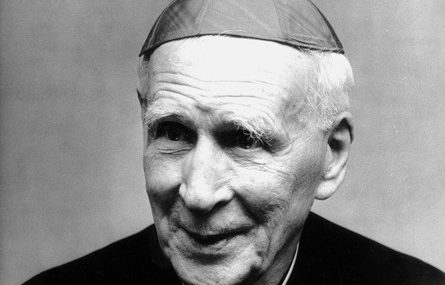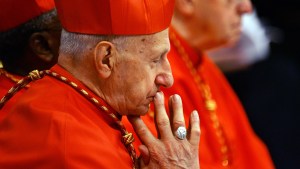Thirty years ago, on September 4, 1991, Jesuit theologian Cardinal Henri de Lubac, died. A prominent figure in international theology in the 20th century, Father Henri de Lubac embodied a movement called the “new theology” and the return to the Church Fathers which definitively marked the thought of the Second Vatican Council. In a letter full of esteem and consideration on the occasion of the French theologian’s eightieth birthday, Paul VI wrote to him: “Your whole life brings honor to you and to the Church.”
From Cambrai to Fourvière
Born on February 20, 1896 in Cambrai, Henri de Lubac, the son of a banker, grew up in an environment with a strong Catholic tradition. He discovered the Society of Jesus at the age of nine, when he entered the Saint-Joseph day school in Lyon, then in Mongré (Villefranche), one of the great Jesuit colleges in France. After a year of law at the Catholic Faculty of Lyon, he entered, at the age of seventeen, the Lyonnais novitiate of the Society, then located in St Leonards-on-Sea, in the south-east of England because of the late 19th and early 20th century anti-congregation laws in France. Then war struck France. Enlisted in 1914 and sent to Verdun in 1916, the young Henri was seriously injured on All Saints’ Day 1917: he would retain the aftereffects of his injury all his life.
Immobilized, he resumed his training in letters and philosophy in England, first at Hales Place north of Canterbury and then, from 1920 to 1923, at Maison Saint-Louis, in Jersey. In a neo-Catholic intellectual climate, he studied Saint Augustine and Saint Thomas, and enthusiastically discovered contemporary philosophers and theologians, such as Pierre Rousselot and Maurice Blondel. The reading of the latter would have a particularly important influence in the future thinking of the theologian—in 1932, he would end up writing to the author of L’Action, telling him how much his reflection on the problem of fundamentalism had prompted his renewed study of the relationship between nature and grace.
When the Jesuits reopened their seminary in France, in Fourvière, in 1926, de Lubac completed his theological studies at Ore Place in Hastings. Two years later, in August 1927, he was ordained a priest. After completing his theological studies in Lyon, de Lubac was appointed to the chair of fundamental theology at the Catholic University in the capital of the Gauls in 1929. In October, he gave an important inaugural lecture entitled “Apologetics and Theology.” The following year, he accepted the request formulated by the dean of the faculty and created a course on the history of religions, a study which confirmed to him “the extraordinary uniqueness of the Christian fact in the dense immensity offered to the gaze of ‘spiritual history of our humanity.'”
Resistance and early writings
While interested in non-Christian religions and philosophies, such as Buddhism and Hinduism, Father de Lubac continued to work vigorously in the properly Christian theological field. In 1938 his fundamental work appeared, Catholicisme: les aspects sociaux du dogme (Catholicism), then Corpus Mysticum: Essai sur L’Eucharistie et l’Église au moyen âge (Corpus Mysticum: The Eucharist and the Church in the Middle Ages), a few years later. At the same time, the theologian of Fourvière founded the “Sources Chrétiennes” series with his Jesuit colleague Jean Daniélou, a series of bilingual and critical editions of early Christian texts and of the Fathers of the Church which contributed to renewing patristic studies and theology itself.
Beginning in 1940, de Lubac played an active role in the spiritual resistance to Nazism, helping in particular with the publication of an underground newspaper of the Nazi resistance, the Christian Testimony, which ran in Lyon, the capital of the resistance at that time. On April 25, 1941, he wrote a text entitled “Letter to my Superiors,” in which he was surprised, at the tragic situation, “to perceive so few signs of concern in Catholic and even ecclesiastical circles.”
De Lubac was convinced of the incompatibility of Christian belief with the philosophy and activities of the Nazi regime, both in Germany and under the guise of the Vichy government in southern France. Several of his newspaper collaborators were captured and executed. In hiding, the theologian continued to write and lead—simultaneously with these activities of resistance—a severe criticism of the paganism and idolatry conveyed by Nazism.
In 1944, with the end of the Nazi occupation of France, Henri de Lubac came out of hiding and published numerous texts that became major works of 20th century Catholic theology. Corpus Mysticum, ready for publication since 1939, appeared in February 1944; Le drame de l’humanisme athée (The Drama of Atheist Humanism), in December 1944; De la Connaissance de Dieu in 1945; Surnaturel: Études historiques was published in 1946 (only 700 copies were printed, due to the shortage of paper).
The New Theology
This last work, barely published, awakened a heated controversy in a Church still in the grip of the modernist crisis. After reading Supernatural and a few other works by the Dominicans of Saulchoir and the Jesuits of Fourvière, Father Reginald Garrigou-Lagrange, a very influential Dominican professor in Rome, decried the controversial concept of “a new theology” and dubbed de Lubac the leader of a movement. The “new theologians” were accused of misunderstanding the relationship between the supernatural and the nature of man, of distorting Thomism by subjecting it to a historical perspective and of relativizing dogmas.
In June 1950, as Lubac put it, “lightning fell on Fourvière.” Four Jesuit professors were accused of “pernicious errors on essential points of dogma.” Banned from teaching and publishing, they were forced to leave the province of Lyon. Jesuit Provincials ordered the withdrawal of three books (Surnaturel, Corpus Mysticum and De la Connaissance de Dieu) and one article by de Lubac from their libraries and, where possible, from public distribution.
Two months later, on August 12, 1950, Pius XII published his encyclical Humani Generis in which he condemned “false opinions which threaten to destroy the foundations of Catholic doctrine.”
Subsequently elected to the Academy of Moral and Political Sciences of the Institut de France, de Lubac lived through this turbulent period with, despite everything, a feeling of great attachment to the Church. Although everything he wrote during these years was subject to censorship in Rome, he did not stop studying, writing and publishing. During these years, he published a study of exegesis on Origen in 1950; three books on Buddhism in 1951, 1952, 1955, respectively; Méditation sur l’Église (The Splendor of the Church) in 1953; andSur les chemins de Dieu (The Discovery of God) in 1956.

Rehabilitation and cardinalate
What Henri de Lubac called “the dark years” would last almost a decade. It was not until 1956 that he was allowed to return to Lyon. Two years later, the University obtained verbal approval from Rome for the theologian to resume the courses he had previously taught.
In 1960, when John XXIII appointed theologians as consultors to the Preparatory Commission for Vatican II, de Lubac was included among the number, along with the Dominican Yves Congar.
De Lubac’s situation improved markedly from 1963 on, under the pontificate of Paul VI. A reader of his Méditation sur l’Église, Bishop Montini quoted him frequently in lectures and invited others to read Le drame de l’humanisme athée. Having become Pope, he made no secret of the esteem he had for the French theologian.
The day after the Council, the rehabilitation of de Lubac was completed. John Paul II added an additional sparkle to it by elevating the theologian to the cardinalate in 1983. The two men got to know each other at the Council, during the drafting of “diagram 13,” the future document Gaudium et Spes. “It didn’t take much observation to discover a very prominent personality in him. He knew my works, and we quickly sympathized,” de Lubac once said of the young Bishop Wojtyla.
De Lubac continued to publish demanding works: his Pic de la Mirandole appeared in 1974 and the two volumes of La Posterérité by Joachim de Flore (1979 and 1981). At the same time, the cardinal did not hide his reservations regarding currents active in the Church, which seemed to him more ideological than theological. He died on September 4, 1991, at the age of ninety-five: his funeral was celebrated at Notre-Dame de Paris.


